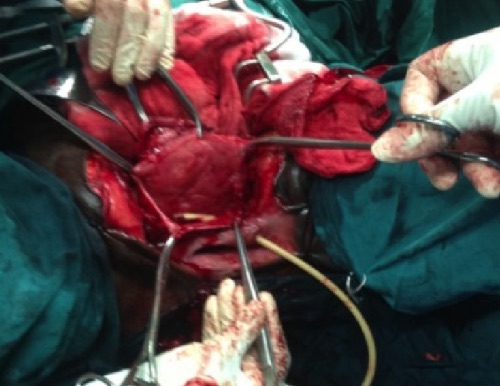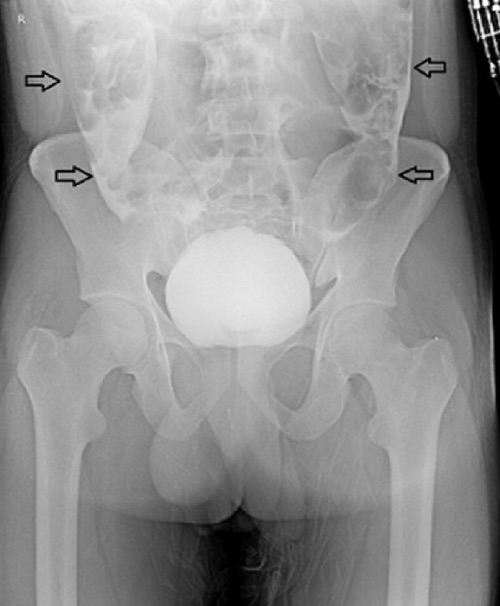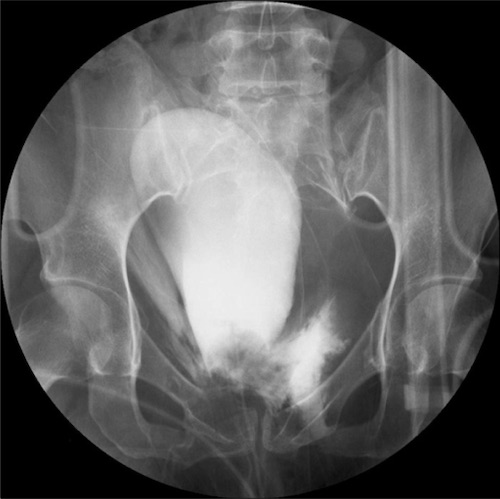Bladder Trauma
Bladder Trauma
David Ray Velez, MD
Table of Contents
Background
Classification
- Intraperitoneal (60% – Most Common)
- Extraperitoneal (30%)
- About 10% are Combined Injuries with Both Intraperitoneal and Extraperitoneal Components
Etiology
- Most Common After Blunt Abdominal Trauma
- 80-90% are Associated with Pelvic Fractures
- Most Common Associated Fracture: Obturator Ring
- Can Be Caused by Shear Forces, Sudden Compression of a Distended Bladder, or Penetrating Injury from a Pelvic Fracture
AAST Bladder Injury Scale
- *See AAST
- Injury Scale is Under Copyright

Bladder Trauma 1
Diagnosis
Presentation
- Gross Hematuria – The Cardinal Sign of Bladder Injury
- Very Reliable (95-100%)
- < 5% of Cases Only Have Microscopic Hematuria
- Lower Abdominal Pain
- Oliguria (Low Urine Output)
May Be Diagnosed Intraoperatively or on Radiographic Imaging
Diagnosis
- CT Cystography is the Standard Method for Diagnosis
- Inject 300-400 cc of Contrast Through the Foley to Distend the Bladder and Clamp
- Findings:
- Intraperitoneal Leak: Contrast Outlines Loops of Bowel or Fills Cul-De-Sac
- Extraperitoneal Leak: Flame or Starburst Pattern of Contrast Extravasation
- Must Obtain Post-Drainage Films if Conventional Cystography (XR Fluoroscopy) is Performed – Risk for False Negatives Without
- May Be Diagnosed by Cystoscopy in Select Circumstances

Intraperitoneal Bladder Rupture 2

Extraperitoneal Bladder Rupture 3
Treatment
Intraperitoneal Rupture: Surgical Repair
- Debride Devitalized Tissue and Repair Primarily
- Use Absorbable Sutures in 2 Layers – Permanent Sutures Irritate the Mucosa and Are Lithogenic
- Foley Catheter Left Indwelling Postoperatively for 7-10 Days
- Consider Cystogram Prior to Removal to Confirm Extravasation is Resolved Prior to Foley Removal – Debated
Extraperitoneal Rupture: Nonoperative Management with Foley Catheter
- Nonoperative Management:
- Foley Catheter Left Indwelling for at Least 10-14 Days
- Cystogram Repeated Every 7-10 Days
- Foley Removed Once Extravasation is Resolved
- Nonoperative Management is Successful in > 85% of Cases
- Indications for Surgical Repair:
- Need for Pelvic Exploration for Other Causes
- Open Pelvic Fracture with Bone Exposed in the Bladder Lumen
- Concurrent Vaginal Injury
- Concurrent Rectal Injury
- Bladder Neck Injury/Avulsion
- Persistent Hematuria/Clots Causing Catheter Obstruction
References
- Ojewola RW, Tijani KH, Badmus OO, Oliyide AE, Osegbe CE. Extraperitoneally Ruptured, Everted, and Prolapsed Bladder: A Very Rare Complication of Pelvic Injury. Case Rep Urol. 2015;2015:476043. (License: CC BY-3.0)
- Vagholkar K, Vagholkar S. Posttraumatic Haematuria with Pseudorenal Failure: A Diagnostic Lead for Intraperitoneal Bladder Rupture. Case Rep Emerg Med. 2016;2016:4521827. (License: CC BY-4.0)
- Kim JH, Ha YC, Kim TH, Myung SC, Moon YT, Kim KD, Chang IH. Delayed presentation of intravesical bone penetration after pelvic ring fracture. Korean J Urol. 2012 Dec;53(12):887-9. (License: CC BY-NC-3.0)
